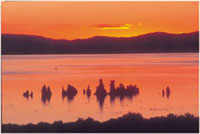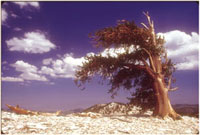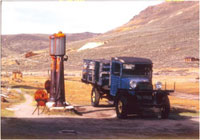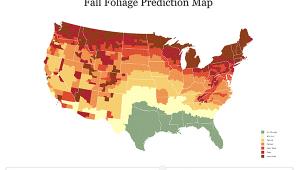A Photographers Dream
Mono Lake And The Eastern Sierra Nevada
Riddle: what do Ansel Adams,
the Lone Ranger, Hopalong Cassidy, William Mulholland, and Gunga Din
all have in common? Answer: a geographical area of California that is
as rich in human history, geological wonder, and photographic beauty
as any place you could imagine. This area is easily traversed by car
in a few short hours, but requires a lifetime to get to know intimately.
Thousands pass through it following US 395 to the casinos of Tahoe and
Reno or the ski slopes of Mammoth Mountain, but seldom stop to take
the opportunity to really explore this remarkable place. |
|||
Let me stress
that this country is predominately desert, and as such, in the summer
it's hot, very hot. Probably the best times to visit are spring
and fall, although I was at Mono Lake last winter and it was wonderful.
Cold, but wonderful. Anything we didn't want to freeze we had to
put in the refrigerator, but we got some great photographs. Sights And Route If you travel north on Highway 14 from the town of Mojave you will pass through Red Rock Canyon State Park on the flanks of the El Paso Mountains. This area has fanciful wind and water carved features and, especially early and late in the day, colors you won't believe are real. You won't be needing any of those warming filters here. As you proceed north, you will enter an area rich in mining history. Gold, silver, borax, and other minerals were taken in greater or lesser quantities, and some mining is still taking place. If you dig old mining towns (pun intended) this part of the valley is worth a prolonged visit. There are a number of guidebooks that will help you find deserted ghost towns and even some not-quite-deserted ones like Randsburg. Another town that barely resists extinction is Keeler. Once a terminus for the silver coming out of the Cerro Gordo Mines above Owens Lake, it now has a few ramshackle homes and a million dollar view of the Sierra Nevada. The steam ship Bessie Brady would pick up the ore at Keeler and deliver it to Olancha across the lake. From there it would be shipped to Los Angeles. |
|||
Movie Sets |
|||
Base Camp |
|||
Fabulous Mono Lake Bodie State Historical Park
Global Preservation Project
Mono Lake Committee Hiking and Trail Guidebooks:
Spotted Dog Press, Bishop, California Photo Traveler's Guide Bishop, California, Traveler's
Information Lone Pine Traveler's
Information California Fall Color Reports Interagency Visitor Center,
Lone Pine, California Manzanar National Historic
Site
|
- Log in or register to post comments





















































